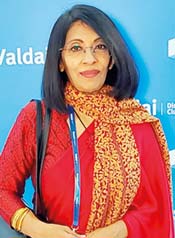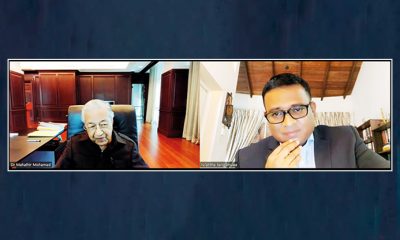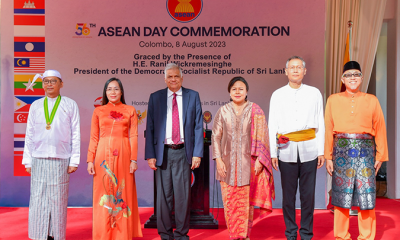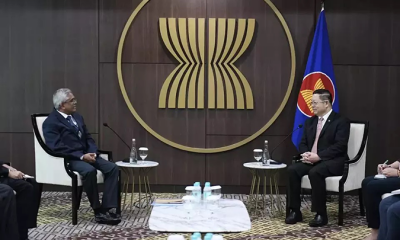Features
Russia, Asia, Civilizations & Multipolarity: The Valdai View
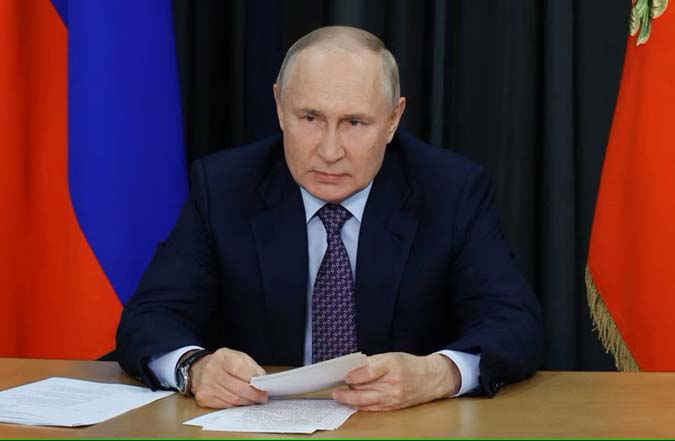
bt Sanja de Silva Jayatilleka
The Valdai Discussion Club, established in 2004 and named after Lake Valdai in Russia where its first meeting was held, meets every year to evaluate global political and economic issues, to work at “forming the global agenda” and to “promote dialogue among the global intellectual elite in order to find solutions to overcome the crises of the international system”. (Valdai Club ). This they have achieved over the years, gaining in prestige, with the 20th Valdai held in Sochi, Russia last week (Oct 2nd -5th 2023) seeing over 100 delegates from 42 countries participate despite the on-going conflict in Ukraine.
This year too, as in previous years, President Putin attended the conference for the plenary session on the last day, to be interviewed by Valdai’s Professor Fydor Lukyanov and to answer the delegates’ questions with which he engaged at length, and in good spirits. Surprisingly relaxed and at ease, given the situation of the on-going conflict, and keen to engage with the foreign delegates, he seemed to enjoy his question time with them making no effort to cut short the over three hours session. Significantly, even though he surely must be under severe pressure, at no time did he show any trace of impatience or lose his cool in any way, despite some frank questions addressed to him.
Greater Connectivity
What emerged at this year’s Valdai sessions was how Asia is gaining in significance and influence as the global order is sought to be re-balanced. The phenomenon of the ‘Asian Paradox’, described as “hot economics, cold politics”, where deteriorating political equations between countries do not hinder increasing economic activity, has been beneficial to global economic growth, such as between Japan and China, China and India, China and Vietnam and indeed China and the US. (‘Russia & Asia: The Paradoxes of a New Reality’, Valdai Discussion Club Report).
There has been significant movement towards greater connectivity between Russia and the major Asian economies, with the conference calling for further consolidation of those relationships. A North-South trade corridor to improve logistics is part of the on-going efforts.
Russia’s economy was described as adaptive and highly diversified, with a stress resistant banking system, which has now been established. With significant economic growth at 5.2% and low unemployment, Russia feels itself recovered from sanctions shock and is looking to expand its trade and economic relations with the global south.
Most Asian countries did not participate in the US sanctions against Russia. As such, the attempted isolation of Russia through the sanctions regime was termed a “miscalculation”, which actually inspired a transition of trade from West to East. The Valdai publication on Russia and Asia concludes that Asian countries have made their decisions based on their national interest, taking advantage of Russia’s pivot to the East rather than be influenced by “outside pressure at the expense of common sense or mutually beneficial cooperation”. It asserts that this “positive attitude towards Russia” has been helped by the fact that Russia does not attempt to influence their foreign policy choices nor interfere with their internal affairs.
South Asia
India remained neutral on the Ukraine issue, refusing to be pressured into denouncing Russia, its “special strategic partner”. India’s trade with Russia has increased since the sanctions. It has surpassed US$40 billion, with Russia now among the top five of India’s trading partners. Russia is the largest supplier of oil to India ahead of Saudi Arabia and Iraq in crude oil deliveries. Rosneft, the most active operator in India had invited an Indian national to join its Board of Directors this year.
An Aide to President Putin confirmed that Russia will invest more in India, confirming that Aisa is now the main driver of global growth. Russia is already building a nuclear power plant in India. In Bangladesh, the building of a nuclear power plant agreed with Russia in 2017 is already underway. In June this year, Bangladesh applied to join BRICS.
During the conference, it was also suggested by the Indian delegation that Russia should consider using its skilled labour to mitigate the labour shortage in Russia, which suggestion was favourably received. It was revealed that there are already 30,000 Indians working in Russia.
On the eve of this year’s conference, the prestigious Indian think tank, the Vivekananda International Foundation, influential with India’s current administration, signed a Memorandum of Understanding with the Valdai Discussion Club.
ASEAN
Except for Singapore, all ASEAN countries stayed neutral on the on-going conflict with Ukraine. Malaysia doubled its imports from Russa in 2022, with several areas of bilateral cooperation such as agriculture and high-tech industries, like aircraft and engine building, electronics and bio-medicine.
A young Malaysian delegate to the conference turned out to have Sri Lankan roots where one his grandfathers had moved first to Singapore and then to Malaysia. Benedict Weerasena, heads a think-tank and made a presentation on Monetary Policy and Multipolarity. He said that ASEAN had agreed to trade in non-dollar settlements, and trade between India and Malaysia will be settled this way. He said de-dollarization had increased trading in the ASEAN region and given them “economic sovereignty.” He cited Malaysia’s and most of the ASEAN’s neutrality on the Ukraine issue as a result of the region prioritizing local economic concerns over ideological alignments.
He also revealed that the tendency towards de-globalization has shifted attention to regional markets and increasing regional economic integration, adding that Malaysia had revived the idea of an Asian Monetary Fund.
Russia-China
The most important relationship for Russia is the one with China. It is reported that President Xi had reiterated the “strategic interaction and cooperation” between the two countries”, when he visited Moscow in March this year. He had also wished President Putin for the upcoming Presidential Elections in 2024.
Last year, Russian exports to China had grown by 43.4% with total trade exceeding US$190 billion. In Addition, it is reported that Chinese “dual-use products” and “non-lethal military equipment” is in operation in the special military zone, such as unmanned aerial vehicles, communication devices, body armour, helmets and uniforms. It is felt that the expanding list of items points towards a “comprehensive defence cooperation”, including Chinese lethal weapons to the conflict zone. The media had reported Chinese armoured vehicles active in the “special operation zone.”
Russia emerged as China’s fastest growing export partner and the two countries had concluded 80% of their trade in local currencies, circumventing what was termed the ‘Western financial infrastructure’. China is seen as Russia’s ‘indispensable’ economic partner, with China’s share of automobile exports from Russia exceeding 70% and Russia increasing its position as China’s largest oil supplier. This improving economic relationship with China is expected to have a positive spill over affect resulting in increased trade with other Asian countries.
Russian Civilization
Russia is keen to share with the world its self-identity as a “distinctive civilization state”. This new foreign policy concept looks to its history and culture to extract a system of values, drawing from their wealth of historical experience, incorporating also the important role played by its spirituality, the Orthodox Chirstian church, and the multiplicity of religions practiced there which includes a large Muslim minority and a much smaller Buddhist community.
Thus, the conference included for the first time a new session on the Russian Civilization, chaired by Dr Dayan Jayatilleka (my spouse) who had to find a way to reconcile the universal values that Russia had already exported to the world with its new desire to relate to the world from the vantage point of its distinct civilization.
Responding to Russian panelists steeped in Eastern Orthodox Christianity and suspicious of the word “universal” which they felt had been imposed on other countries by a hegemonic West, Dayan quoted St. Paul’s Third Epistle to the Galatians (“There is no longer Jew or Greek, there is no longer slave or free, there is no longer male and female; for all of you are one in Christ Jesus”) to illustrate the point that the notion of universality started with St. Paul, who is accepted by all Christian denominations, antedating the schism. Dayan proposed a redefined universality rather than a rejection of the notion of universality itself in response to the West-centric one in existence.
This redefinition could retain the sense of a distinctive civilizational heritage, interact with other civilizations and contribute to a more authentic universality which respected differences. Citing Vietnam which has a 5,000-year civilization, he said that confronting great national challenges is best done by a synthesis of civilization, modernity and universality.
[Sanja de Silva Jayatilleka was an invited participant at the 20th Valdai sessions in Sochi, Russia, Oct 2-5. The Conference theme was ‘Fair Multipolarity: How to Ensure Security & Development for Everyone’.]
Features
The heart-friendly health minister

by Dr Gotabhya Ranasinghe
Senior Consultant Cardiologist
National Hospital Sri Lanka
When we sought a meeting with Hon Dr. Ramesh Pathirana, Minister of Health, he graciously cleared his busy schedule to accommodate us. Renowned for his attentive listening and deep understanding, Minister Pathirana is dedicated to advancing the health sector. His openness and transparency exemplify the qualities of an exemplary politician and minister.
Dr. Palitha Mahipala, the current Health Secretary, demonstrates both commendable enthusiasm and unwavering support. This combination of attributes makes him a highly compatible colleague for the esteemed Minister of Health.
Our discussion centered on a project that has been in the works for the past 30 years, one that no other minister had managed to advance.
Minister Pathirana, however, recognized the project’s significance and its potential to revolutionize care for heart patients.
The project involves the construction of a state-of-the-art facility at the premises of the National Hospital Colombo. The project’s location within the premises of the National Hospital underscores its importance and relevance to the healthcare infrastructure of the nation.
This facility will include a cardiology building and a tertiary care center, equipped with the latest technology to handle and treat all types of heart-related conditions and surgeries.
Securing funding was a major milestone for this initiative. Minister Pathirana successfully obtained approval for a $40 billion loan from the Asian Development Bank. With the funding in place, the foundation stone is scheduled to be laid in September this year, and construction will begin in January 2025.
This project guarantees a consistent and uninterrupted supply of stents and related medications for heart patients. As a result, patients will have timely access to essential medical supplies during their treatment and recovery. By securing these critical resources, the project aims to enhance patient outcomes, minimize treatment delays, and maintain the highest standards of cardiac care.
Upon its fruition, this monumental building will serve as a beacon of hope and healing, symbolizing the unwavering dedication to improving patient outcomes and fostering a healthier society.We anticipate a future marked by significant progress and positive outcomes in Sri Lanka’s cardiovascular treatment landscape within the foreseeable timeframe.
Features
A LOVING TRIBUTE TO JESUIT FR. ALOYSIUS PIERIS ON HIS 90th BIRTHDAY

by Fr. Emmanuel Fernando, OMI
Jesuit Fr. Aloysius Pieris (affectionately called Fr. Aloy) celebrated his 90th birthday on April 9, 2024 and I, as the editor of our Oblate Journal, THE MISSIONARY OBLATE had gone to press by that time. Immediately I decided to publish an article, appreciating the untiring selfless services he continues to offer for inter-Faith dialogue, the renewal of the Catholic Church, his concern for the poor and the suffering Sri Lankan masses and to me, the present writer.
It was in 1988, when I was appointed Director of the Oblate Scholastics at Ampitiya by the then Oblate Provincial Fr. Anselm Silva, that I came to know Fr. Aloy more closely. Knowing well his expertise in matters spiritual, theological, Indological and pastoral, and with the collaborative spirit of my companion-formators, our Oblate Scholastics were sent to Tulana, the Research and Encounter Centre, Kelaniya, of which he is the Founder-Director, for ‘exposure-programmes’ on matters spiritual, biblical, theological and pastoral. Some of these dimensions according to my view and that of my companion-formators, were not available at the National Seminary, Ampitiya.
Ever since that time, our Oblate formators/ accompaniers at the Oblate Scholasticate, Ampitiya , have continued to send our Oblate Scholastics to Tulana Centre for deepening their insights and convictions regarding matters needed to serve the people in today’s context. Fr. Aloy also had tried very enthusiastically with the Oblate team headed by Frs. Oswald Firth and Clement Waidyasekara to begin a Theologate, directed by the Religious Congregations in Sri Lanka, for the contextual formation/ accompaniment of their members. It should very well be a desired goal of the Leaders / Provincials of the Religious Congregations.
Besides being a formator/accompanier at the Oblate Scholasticate, I was entrusted also with the task of editing and publishing our Oblate journal, ‘The Missionary Oblate’. To maintain the quality of the journal I continue to depend on Fr. Aloy for his thought-provoking and stimulating articles on Biblical Spirituality, Biblical Theology and Ecclesiology. I am very grateful to him for his generous assistance. Of late, his writings on renewal of the Church, initiated by Pope St. John XX111 and continued by Pope Francis through the Synodal path, published in our Oblate journal, enable our readers to focus their attention also on the needed renewal in the Catholic Church in Sri Lanka. Fr. Aloy appreciated very much the Synodal path adopted by the Jesuit Pope Francis for the renewal of the Church, rooted very much on prayerful discernment. In my Religious and presbyteral life, Fr.Aloy continues to be my spiritual animator / guide and ongoing formator / acccompanier.
Fr. Aloysius Pieris, BA Hons (Lond), LPh (SHC, India), STL (PFT, Naples), PhD (SLU/VC), ThD (Tilburg), D.Ltt (KU), has been one of the eminent Asian theologians well recognized internationally and one who has lectured and held visiting chairs in many universities both in the West and in the East. Many members of Religious Congregations from Asian countries have benefited from his lectures and guidance in the East Asian Pastoral Institute (EAPI) in Manila, Philippines. He had been a Theologian consulted by the Federation of Asian Bishops’ Conferences for many years. During his professorship at the Gregorian University in Rome, he was called to be a member of a special group of advisers on other religions consulted by Pope Paul VI.
Fr. Aloy is the author of more than 30 books and well over 500 Research Papers. Some of his books and articles have been translated and published in several countries. Among those books, one can find the following: 1) The Genesis of an Asian Theology of Liberation (An Autobiographical Excursus on the Art of Theologising in Asia, 2) An Asian Theology of Liberation, 3) Providential Timeliness of Vatican 11 (a long-overdue halt to a scandalous millennium, 4) Give Vatican 11 a chance, 5) Leadership in the Church, 6) Relishing our faith in working for justice (Themes for study and discussion), 7) A Message meant mainly, not exclusively for Jesuits (Background information necessary for helping Francis renew the Church), 8) Lent in Lanka (Reflections and Resolutions, 9) Love meets wisdom (A Christian Experience of Buddhism, 10) Fire and Water 11) God’s Reign for God’s poor, 12) Our Unhiddden Agenda (How we Jesuits work, pray and form our men). He is also the Editor of two journals, Vagdevi, Journal of Religious Reflection and Dialogue, New Series.
Fr. Aloy has a BA in Pali and Sanskrit from the University of London and a Ph.D in Buddhist Philosophy from the University of Sri Lankan, Vidyodaya Campus. On Nov. 23, 2019, he was awarded the prestigious honorary Doctorate of Literature (D.Litt) by the Chancellor of the University of Kelaniya, the Most Venerable Welamitiyawe Dharmakirthi Sri Kusala Dhamma Thera.
Fr. Aloy continues to be a promoter of Gospel values and virtues. Justice as a constitutive dimension of love and social concern for the downtrodden masses are very much noted in his life and work. He had very much appreciated the commitment of the late Fr. Joseph (Joe) Fernando, the National Director of the Social and Economic Centre (SEDEC) for the poor.
In Sri Lanka, a few religious Congregations – the Good Shepherd Sisters, the Christian Brothers, the Marist Brothers and the Oblates – have invited him to animate their members especially during their Provincial Congresses, Chapters and International Conferences. The mainline Christian Churches also have sought his advice and followed his seminars. I, for one, regret very much, that the Sri Lankan authorities of the Catholic Church –today’s Hierarchy—- have not sought Fr.
Aloy’s expertise for the renewal of the Catholic Church in Sri Lanka and thus have not benefited from the immense store of wisdom and insight that he can offer to our local Church while the Sri Lankan bishops who governed the Catholic church in the immediate aftermath of the Second Vatican Council (Edmund Fernando OMI, Anthony de Saram, Leo Nanayakkara OSB, Frank Marcus Fernando, Paul Perera,) visited him and consulted him on many matters. Among the Tamil Bishops, Bishop Rayappu Joseph was keeping close contact with him and Bishop J. Deogupillai hosted him and his team visiting him after the horrible Black July massacre of Tamils.
Features
A fairy tale, success or debacle

Sri Lanka-Singapore Free Trade Agreement
By Gomi Senadhira
senadhiragomi@gmail.com
“You might tell fairy tales, but the progress of a country cannot be achieved through such narratives. A country cannot be developed by making false promises. The country moved backward because of the electoral promises made by political parties throughout time. We have witnessed that the ultimate result of this is the country becoming bankrupt. Unfortunately, many segments of the population have not come to realize this yet.” – President Ranil Wickremesinghe, 2024 Budget speech
Any Sri Lankan would agree with the above words of President Wickremesinghe on the false promises our politicians and officials make and the fairy tales they narrate which bankrupted this country. So, to understand this, let’s look at one such fairy tale with lots of false promises; Ranil Wickremesinghe’s greatest achievement in the area of international trade and investment promotion during the Yahapalana period, Sri Lanka-Singapore Free Trade Agreement (SLSFTA).
It is appropriate and timely to do it now as Finance Minister Wickremesinghe has just presented to parliament a bill on the National Policy on Economic Transformation which includes the establishment of an Office for International Trade and the Sri Lanka Institute of Economics and International Trade.
Was SLSFTA a “Cleverly negotiated Free Trade Agreement” as stated by the (former) Minister of Development Strategies and International Trade Malik Samarawickrama during the Parliamentary Debate on the SLSFTA in July 2018, or a colossal blunder covered up with lies, false promises, and fairy tales? After SLSFTA was signed there were a number of fairy tales published on this agreement by the Ministry of Development Strategies and International, Institute of Policy Studies, and others.
However, for this article, I would like to limit my comments to the speech by Minister Samarawickrama during the Parliamentary Debate, and the two most important areas in the agreement which were covered up with lies, fairy tales, and false promises, namely: revenue loss for Sri Lanka and Investment from Singapore. On the other important area, “Waste products dumping” I do not want to comment here as I have written extensively on the issue.
1. The revenue loss
During the Parliamentary Debate in July 2018, Minister Samarawickrama stated “…. let me reiterate that this FTA with Singapore has been very cleverly negotiated by us…. The liberalisation programme under this FTA has been carefully designed to have the least impact on domestic industry and revenue collection. We have included all revenue sensitive items in the negative list of items which will not be subject to removal of tariff. Therefore, 97.8% revenue from Customs duty is protected. Our tariff liberalisation will take place over a period of 12-15 years! In fact, the revenue earned through tariffs on goods imported from Singapore last year was Rs. 35 billion.
The revenue loss for over the next 15 years due to the FTA is only Rs. 733 million– which when annualised, on average, is just Rs. 51 million. That is just 0.14% per year! So anyone who claims the Singapore FTA causes revenue loss to the Government cannot do basic arithmetic! Mr. Speaker, in conclusion, I call on my fellow members of this House – don’t mislead the public with baseless criticism that is not grounded in facts. Don’t look at petty politics and use these issues for your own political survival.”
I was surprised to read the minister’s speech because an article published in January 2018 in “The Straits Times“, based on information released by the Singaporean Negotiators stated, “…. With the FTA, tariff savings for Singapore exports are estimated to hit $10 million annually“.
As the annual tariff savings (that is the revenue loss for Sri Lanka) calculated by the Singaporean Negotiators, Singaporean $ 10 million (Sri Lankan rupees 1,200 million in 2018) was way above the rupees’ 733 million revenue loss for 15 years estimated by the Sri Lankan negotiators, it was clear to any observer that one of the parties to the agreement had not done the basic arithmetic!
Six years later, according to a report published by “The Morning” newspaper, speaking at the Committee on Public Finance (COPF) on 7th May 2024, Mr Samarawickrama’s chief trade negotiator K.J. Weerasinghehad had admitted “…. that forecasted revenue loss for the Government of Sri Lanka through the Singapore FTA is Rs. 450 million in 2023 and Rs. 1.3 billion in 2024.”
If these numbers are correct, as tariff liberalisation under the SLSFTA has just started, we will pass Rs 2 billion very soon. Then, the question is how Sri Lanka’s trade negotiators made such a colossal blunder. Didn’t they do their basic arithmetic? If they didn’t know how to do basic arithmetic they should have at least done their basic readings. For example, the headline of the article published in The Straits Times in January 2018 was “Singapore, Sri Lanka sign FTA, annual savings of $10m expected”.
Anyway, as Sri Lanka’s chief negotiator reiterated at the COPF meeting that “…. since 99% of the tariffs in Singapore have zero rates of duty, Sri Lanka has agreed on 80% tariff liberalisation over a period of 15 years while expecting Singapore investments to address the imbalance in trade,” let’s turn towards investment.
Investment from Singapore
In July 2018, speaking during the Parliamentary Debate on the FTA this is what Minister Malik Samarawickrama stated on investment from Singapore, “Already, thanks to this FTA, in just the past two-and-a-half months since the agreement came into effect we have received a proposal from Singapore for investment amounting to $ 14.8 billion in an oil refinery for export of petroleum products. In addition, we have proposals for a steel manufacturing plant for exports ($ 1 billion investment), flour milling plant ($ 50 million), sugar refinery ($ 200 million). This adds up to more than $ 16.05 billion in the pipeline on these projects alone.
And all of these projects will create thousands of more jobs for our people. In principle approval has already been granted by the BOI and the investors are awaiting the release of land the environmental approvals to commence the project.
I request the Opposition and those with vested interests to change their narrow-minded thinking and join us to develop our country. We must always look at what is best for the whole community, not just the few who may oppose. We owe it to our people to courageously take decisions that will change their lives for the better.”
According to the media report I quoted earlier, speaking at the Committee on Public Finance (COPF) Chief Negotiator Weerasinghe has admitted that Sri Lanka was not happy with overall Singapore investments that have come in the past few years in return for the trade liberalisation under the Singapore-Sri Lanka Free Trade Agreement. He has added that between 2021 and 2023 the total investment from Singapore had been around $162 million!
What happened to those projects worth $16 billion negotiated, thanks to the SLSFTA, in just the two-and-a-half months after the agreement came into effect and approved by the BOI? I do not know about the steel manufacturing plant for exports ($ 1 billion investment), flour milling plant ($ 50 million) and sugar refinery ($ 200 million).
However, story of the multibillion-dollar investment in the Petroleum Refinery unfolded in a manner that would qualify it as the best fairy tale with false promises presented by our politicians and the officials, prior to 2019 elections.
Though many Sri Lankans got to know, through the media which repeatedly highlighted a plethora of issues surrounding the project and the questionable credentials of the Singaporean investor, the construction work on the Mirrijiwela Oil Refinery along with the cement factory began on the24th of March 2019 with a bang and Minister Ranil Wickremesinghe and his ministers along with the foreign and local dignitaries laid the foundation stones.
That was few months before the 2019 Presidential elections. Inaugurating the construction work Prime Minister Ranil Wickremesinghe said the projects will create thousands of job opportunities in the area and surrounding districts.
The oil refinery, which was to be built over 200 acres of land, with the capacity to refine 200,000 barrels of crude oil per day, was to generate US$7 billion of exports and create 1,500 direct and 3,000 indirect jobs. The construction of the refinery was to be completed in 44 months. Four years later, in August 2023 the Cabinet of Ministers approved the proposal presented by President Ranil Wickremesinghe to cancel the agreement with the investors of the refinery as the project has not been implemented! Can they explain to the country how much money was wasted to produce that fairy tale?
It is obvious that the President, ministers, and officials had made huge blunders and had deliberately misled the public and the parliament on the revenue loss and potential investment from SLSFTA with fairy tales and false promises.
As the president himself said, a country cannot be developed by making false promises or with fairy tales and these false promises and fairy tales had bankrupted the country. “Unfortunately, many segments of the population have not come to realize this yet”.
(The writer, a specialist and an activist on trade and development issues . )

